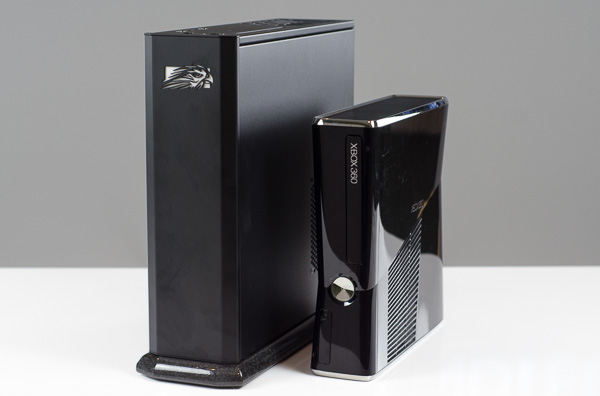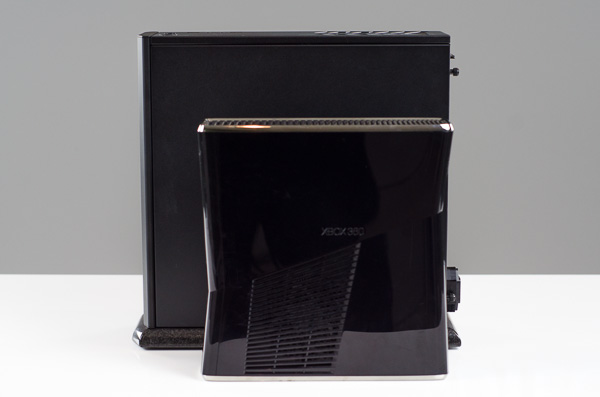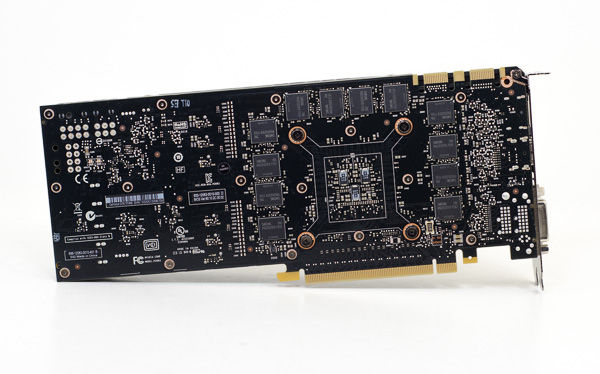High-End Meets Small Form Factor: GeForce Titan in Falcon Northwest's Tiki
by Anand Lal Shimpi on February 19, 2013 9:00 AM ESTPrice and Final Words
I like the Tiki chassis. It's big enough to accommodate the type of parts I'd want to integrate, yet it's small enough to feel more like a console than a huge gaming PC. The styling is simple and understated, allowing the system's size to be the main thing on display.
I've personally never been a fan of multi-GPU setups, I much prefer the simplicity of a single, high performance GPU. For a user like me, the GeForce Titan in Falcon's Tiki is pretty much as good as it gets. I was pleasantly surprised by the amount of performance that could be squeezed into a fairly small chassis, without being overly loud. The Tiki wasn't silent, but the days of having to make a trade off between something annoying and something fast are over. It's sort of absurd that between the Core i7 and Titan there are 8.5 billion transistors switching at ridiculous speeds inside this tiny chassis.
Personally I don't know that I'd ever build or buy something as insane as this setup, but that's not to say that I don't appreciate it. A 4.6GHz Core i7 paired with an single, speedy GPU is just a great combination for a gaming system. The fact that it comes in a sleek form factor is icing on the cake.
Kelt was always hesitant to send a Tiki over for review at AnandTech. The system isn't cheap. In its default configuration with a Core i5-3470 with 8GB of RAM and a 128GB Crucial m4 SSD you're looking at a price of around $1713. You can definitely build something faster for a lot cheaper. When you're spending a clean $1K just on your GPU however, a more expensive overall system cost isn't all that unreasonable. While I didn't have final pricing for the review system, the Tiki system I tested without Titan would retail for $2263. I'd expect the final price with Titan to be somewhere around $3200.
In a world where Apple sells $2000 - $3000 Macs based around their experience, I don't see why the same sort of logic can't apply here as well. What has traditionally kept PC vendors from being able to sell on an experience has really been an issue with the software side of the story. With Steam and Big Picture, Valve is helping to address some of those weaknesses.
Falcon built a system that you wouldn't mind having in your living room, much like you would a gaming console, but I do see a lot of potential in the usage model NVIDIA outlined at CES. With your gaming PC in your office streaming content to your TV when you want more of that console experience.
The quest for more power efficient hardware has done wonderful things for the mobile industry, but I believe the PC gaming market stands to benefit as well. Although we asked NVIDIA for both a 3-way SLI system and small form factor box based on GeForce Titan, we did so out of necessity. When faced with the choice of what we'd rather have personally, both Ryan and I agreed that a single Titan in a small form factor chassis is the way to go.













33 Comments
View All Comments
Aikouka - Tuesday, February 19, 2013 - link
I wanted to add one thing to your comparison between the Tiki and the 360 that I think makes it even more interesting: the power supply. It's pretty easy to forget given we don't necessarily consider it, but if they stuffed the power supply into the 360, it would probably come even closer to the size of the Tiki.As for Steam's Big Picture Mode (BPM), what I would love to see is better thought to the user experience. I use BPM on my Gaming HTPC along with Windows Media Center (for the superior CableCard-based tuner support). Well, the problem is that there isn't an easy way to cycle between the two pieces of software. The biggest problem is that when you exit BPM, it doesn't actually exit Steam, which can be a good thing since logging into Steam takes an absurdly long time. However, that means that you can't use a piece of software to track when Steam closes and have it reopen WMC. There's a piece of software like that which allows for switching to XBMC from within WMC.
lmcd - Tuesday, February 19, 2013 - link
Or Big Picture could just load in video plug-ins, and handle content management. Since Valve is in digital distribution I could see them teaming up with 7digital or someone to get themselves a store.cjs150 - Tuesday, February 19, 2013 - link
NVidia please produce a watercooled version! That + an i7-3770k in a Silverstone TJ08 with a 200x200mm radiator would produce a quiet, cool and super powerful system.Very impressed with how little power needed to run that system.
Only problem for me is that the GPU is way too powerful for my needs. I havent yet moved up to 1920x1080 monitor.
Falcon sure builds pretty systems
Gigaplex - Tuesday, February 19, 2013 - link
Why would NVIDIA build a watercooled version? They pretty much just build a reference platform and sell chips, it's the OEMs that do custom cooling solutions.alpha754293 - Tuesday, February 19, 2013 - link
What kind/type/speed and how much RAM is in the system that you reviewed here?mavere - Tuesday, February 19, 2013 - link
"My perspective on what's considered quiet has been sort of warped by the fact that for the past two months I've been using a 27-inch iMac as my primary system."Uhhh I get the sense that you're trying to qualify your perspective on system noise somehow, but I don't think iMacs, especially the 27" ones, are mass-market enough to be used as a general reference point.
Can you rephrase and/or link to a review? Thanks.
chizow - Tuesday, February 19, 2013 - link
Eh....don't think so. There's nothing in there that would justify that price point, it makes Alienware's X-51 seem like a steal. And the X-51 looks much nicer to boot.I do like the innovation with the daughter/riser card accomodating a full-sized GPU. Now that the cat is out of the bag on that one however, I expect more OEMs to follow suit, albeit at a much cheaper price tag. $1k + $300 for a GTX 670 would be a very attractive option, imo, and make up for the lack of grunt on the X-51's GPU options.
JonnyDough - Wednesday, February 20, 2013 - link
I'd rather have the IO Sheild/Backpanel at the top of the case, rather than the bottom for the exact reason you listed Anand. You can see it better when plugging in peripherals.The PSU and video card connections can be at the bottom. Plus, your mouse cord might be too short to accommodate your desk. You just never know.
brucek2 - Wednesday, February 20, 2013 - link
I'm surprised there were 1080p settings for Far Cry 3 that this system couldn't play. If this system can't do it... what system were they targeting?!? I guess its nice that game looks to future hardware improvements but targeting a level of hardware power that's significantly above this system seems like a very large gap.marc1000 - Wednesday, March 6, 2013 - link
it's nice to see that BOTH fans are intakes on this small chassis. they are also made by scythe. I wonder where is the PSU air output, but anyway for thermals this is a great design. the only problem would be how to block dust from entering the system.